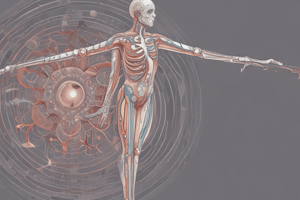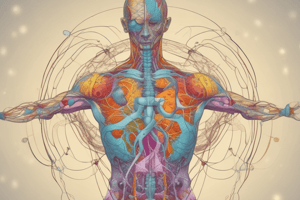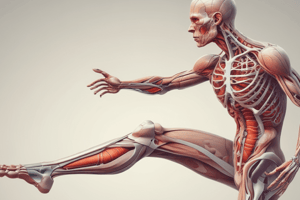Podcast
Questions and Answers
What is the primary role of acid-base balance in the human body?
What is the primary role of acid-base balance in the human body?
To regulate the concentration of free hydrogen ions (H+) in body fluids.
Explain how acidosis affects potassium levels in the body.
Explain how acidosis affects potassium levels in the body.
Acidosis causes decreased secretion of potassium (K+) from the body.
What are the two primary types of acid-base disorders?
What are the two primary types of acid-base disorders?
Acidosis and alkalosis.
How does the Henderson-Hasselbalch equation relate to acid-base balance?
How does the Henderson-Hasselbalch equation relate to acid-base balance?
Identify one source of hydrogen ions (H+) in the body and explain its significance.
Identify one source of hydrogen ions (H+) in the body and explain its significance.
What is the primary mechanism by which the bicarbonate buffer system maintains pH in the extracellular fluid?
What is the primary mechanism by which the bicarbonate buffer system maintains pH in the extracellular fluid?
Explain the role of organic acids in cellular metabolism and their significance in regulation of pH.
Explain the role of organic acids in cellular metabolism and their significance in regulation of pH.
Differentiate between fixed acids and volatile acids, providing examples of each.
Differentiate between fixed acids and volatile acids, providing examples of each.
How do protein buffer systems contribute to pH regulation in the body?
How do protein buffer systems contribute to pH regulation in the body?
Describe the bicarbonate buffer system in detail, including its components and their roles.
Describe the bicarbonate buffer system in detail, including its components and their roles.
Flashcards
Acid-base balance
Acid-base balance
Precise regulation of free hydrogen ion (H+) concentration in body fluids.
Importance of acid-base balance
Importance of acid-base balance
Impacts nerve/muscle excitability, enzyme function, and K+ levels.
Source of H+ ions in body
Source of H+ ions in body
Metabolic processes like carbonic acid formation and organic acid production.
Acidosis
Acidosis
Signup and view all the flashcards
Alkalosis
Alkalosis
Signup and view all the flashcards
Metabolic Acidosis/Alkalosis
Metabolic Acidosis/Alkalosis
Signup and view all the flashcards
Respiratory Acidosis/Alkalosis
Respiratory Acidosis/Alkalosis
Signup and view all the flashcards
Henderson-Hasselbalch equation
Henderson-Hasselbalch equation
Signup and view all the flashcards
Buffer
Buffer
Signup and view all the flashcards
Buffer system
Buffer system
Signup and view all the flashcards
Carbonic acid-bicarbonate buffer system
Carbonic acid-bicarbonate buffer system
Signup and view all the flashcards
Fixed acids
Fixed acids
Signup and view all the flashcards
Organic acids
Organic acids
Signup and view all the flashcards
Volatile acids
Volatile acids
Signup and view all the flashcards
pH regulation (Chemical buffer systems)
pH regulation (Chemical buffer systems)
Signup and view all the flashcards
pH regulation (Physiological buffer systems)
pH regulation (Physiological buffer systems)
Signup and view all the flashcards
Intracellular fluid (ICF)
Intracellular fluid (ICF)
Signup and view all the flashcards
Extracellular fluid (ECF)
Extracellular fluid (ECF)
Signup and view all the flashcards
Phosphate buffer system
Phosphate buffer system
Signup and view all the flashcards
Protein buffer systems
Protein buffer systems
Signup and view all the flashcards
Hemoglobin buffer system
Hemoglobin buffer system
Signup and view all the flashcards
Study Notes
Acid-Base Balance
- Acid-base balance refers to the precise regulation of free hydrogen ion (H+) concentration in body fluids.
- Maintaining acid-base balance is crucial for nerve and muscle cell excitability, enzyme activity, and proper K+ levels.
- Sources of H+ in the body include carbonic acid formation, organic acids from intermediary metabolism, and incomplete metabolism of glucose and fatty acids (lactic acid and ketoacids).
- Hydrolysis of dietary phosphate produces fixed or metabolic acid load that cannot be exhaled, requiring neutralization or excretion by the kidneys.
- Normal blood pH is maintained between 7.35 and 7.45.
- Disturbances in acid-base balance can lead to serious clinical consequences.
Types of Acid-Base Disorders
- Acidosis: A condition where the blood has too much acid (or too little base), resulting in a decrease in blood pH.
- Alkalosis: A condition where the blood has too much base (or too little acid), resulting in an increase in blood pH.
- These disorders are not diseases on their own, but rather result from various underlying conditions.
Henderson-Hasselbalch Equation
- pH = pK + log ([A-]/[HA])
- pH = -log₁₀[H⁺] (pH units)
- pK = -log₁₀K (pH units)
- [A⁻] = Concentration of base form of buffer (mEq/L)
- [HA] = Concentration of acid form of buffer (mEq/L)
Buffers
- Buffers are mixtures of a weak acid and its conjugate base or a weak base and its conjugate acid.
- They immediately combine with any acid or alkali to prevent excessive changes in [H+].
Classes of Acids
- Fixed acids: Do not leave the body in solution; remain in body fluids until eliminated by the kidneys (e.g., sulfuric acid and phosphoric acid).
- Volatile acids: Can leave the body via the lungs, e.g., carbonic acid.
Acid-Base Buffer Systems
- Chemical buffer systems (immediate): Bicarbonate buffer system, phosphate buffer system, protein buffer system.
- Physiological buffer systems (minutes-hours): Respiratory response system, renal response system.
Role of the Lungs in Acid-Base Balance
- The lungs regulate pH by excreting CO2, which affects the amount of carbonic acid in the blood.
- Changes in respiratory rate directly affect CO2 levels and thus, blood pH.
- During acidosis, the respiratory rate increases to eliminate excess CO2.
- During alkalosis, the respiratory rate decreases to retain CO2.
Role of the Kidneys in Acid-Base Balance
- The kidneys slowly adjust blood pH by excreting excess acids or bases.
- Conservation/reabsorption of HCO3⁻, generation of new HCO3⁻, and excretion of H+ as titratable acid or NH4+ are kidney functions involved in pH regulation.
Summary of Acid-Base Disorders
- Disorders are categorized as either respiratory or metabolic, and either acidosis or alkalosis.
- Compensation mechanisms involving the lungs and kidneys are indicated by arrows and descriptions of direction of change in pH.
Studying That Suits You
Use AI to generate personalized quizzes and flashcards to suit your learning preferences.




